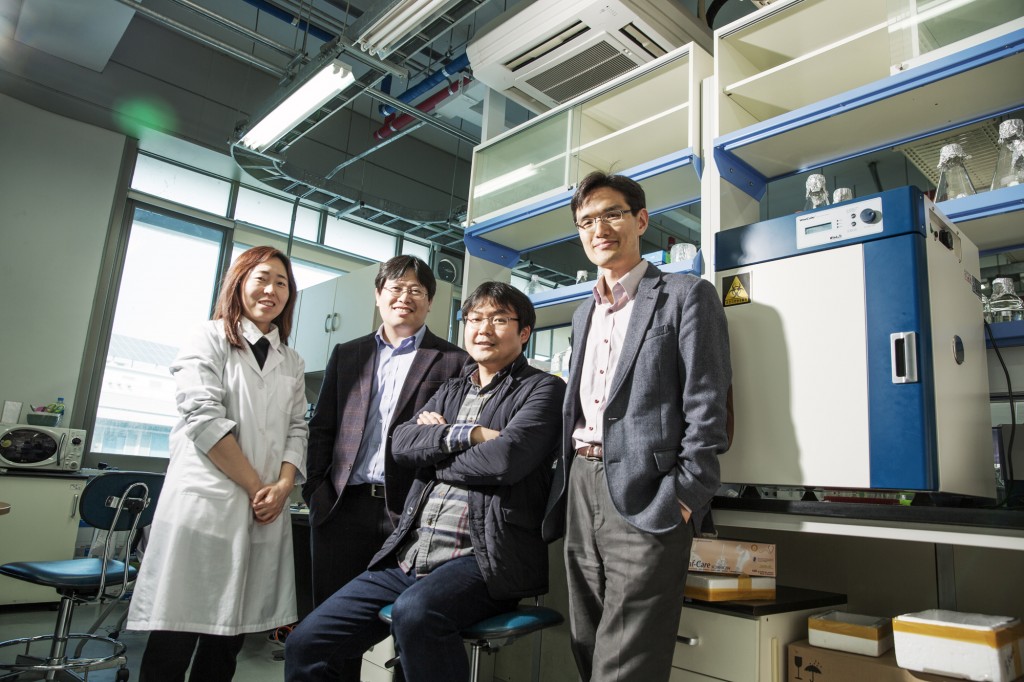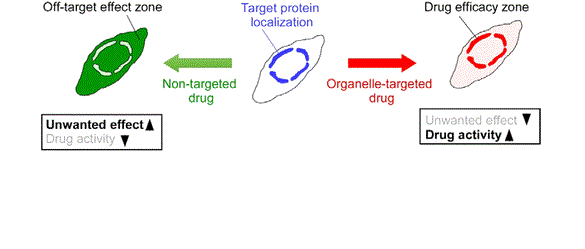On March 18, a team of UNIST and DGMIF researchers announced they have developed a new “smart” cancer therapy they hope may be a breakthrough in treating cancer cells.
This study is a collaboration among scientists, including Prof. Changwook Lee (School of Life Sciences), Prof. Byoung Heon Kang (Department of Biological Sciences), and Prof. Ja Hyoung Ryu (School of Natural Science) at UNIST and Seok Gyun Yoon, Director of the New Drug Development Center at Daegu-Gyeongbuk Medical Innovation Foundation (DGMIF).

From right are, Prof. Byoung Heon Kang (School of Life Sciences), Prof. Changwook Lee (School of Life Sciences), Prof. Ja Hyoung Ryu (School of Natural Science), and the researcher Hye Kyung Park (School of Life Sciences).
Mitochondria, which are known as the ‘power stations’ in our cells, play a crucial role in cellular energy metabolisum, free radical generation, and apoptosis. Moreover, mitochondrial dysfunctions typically found in cancerous cells have long been suspected as many of the hallmarks of cancer, including altered metabolism and resistance to apoptosis. Therefore, targeting the mitochondria to sensitize cancer cells to apoptosis is a major aim in anti-cancer therapeutics. However, studies have shown that while treating damaged mitochondria enhance drug efficacy, it may also aggravate unwanted off-target effects by affecting normal cells.
In this research, the research team proposed Hsp90 and TNF Receptor-associated Protein 1 (TRAP1) as the target proteins for anti-cancer drug development due to their ability to suppress cell death and reprogram energy metabolism in cancer cells. They applied a new type of organelle-specific anti-cancer drugs, called SMTIN-P01 to develop mitochodrial TRAP1 inhibitors and to overcome the limited effects of current Hsp90 inhibitors for TRAP1 inactivation.

The above figure shows the modulation of organelle-resident protein, using organelle-targeted and nontargeted drugs. (Source: http://pubs.acs.org/doi/abs/10.1021/ja511893n)
According to the research team, with the current Hsp90 inhibitors, it has been difficult to activate TRAP1 due to their inefficient accumulation of the drugs in the mitochondria. Therefore, “Current clinical trials of Hsp90 inhibitors are mainly focused on combinations with other cancer drugs,” says the research team …. To develop mitochondrial TRAP1 inhibitors, we determined the crystal structures of human TRAP1 complexed with Hsp90 inhibitors,” says the research team.
The research team states, “[This newly-developed] organelle-specific drugs can be exploited, not only for Hsp90 inhibitors, but also for other therapeutics targeting mitochondrial proteins to improve drug activity, minimize side effects, and often alter the mode of drug actions.”
Prof. Kang at UNIST says “This study has given us new insights into the development of first-in-class anti-cancer drugs.” He adds, “SMTIN-P01 will increase the therapeutic quality and efficacy of an anticancer drug because with this organelle-specific drug, scientists can significanly lower the costs that come about due to adverse drug side effects.”
This research was supported by the Science Research Center Programs and the Basic Science Research Program through the National Research Foundation of Korea, the Korea Health Technology R&D Project through the Korea Health Industry Development Institute (KHIDI) and funded by the Ministry of Health & Welfare of Korea, and Korea Drug Development Fund (KDDF).
The findings have just been published in the Journal of the American Chemical Society, the world’s leading journal for all areas of chemistry.
Journal Reference: Changwook Lee, Hye-Kyung Park, Hanbin Jeong, Jaehwa Lim, An-Jung Lee, Keun Young Cheon, Chul-Su Kim, Ajesh P. Thomas§, Boram Bae, Nam Doo Kim, Seong Heon Kim, Pann-Ghill Suh, Ja-Hyoung Ryu, and Byoung Heon Kang, “Development of a Mitochondria-Targeted Hsp90 Inhibitor Based on the Crystal Structures of Human TRAP1,” J. Am. Chem. Soc., March 2015.
















